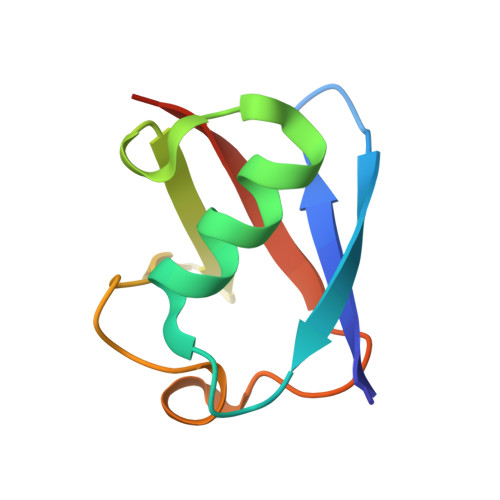Threonine ADP-Ribosylation of Ubiquitin by a Bacterial Effector Family Blocks Host Ubiquitination.
Yan, F., Huang, C., Wang, X., Tan, J., Cheng, S., Wan, M., Wang, Z., Wang, S., Luo, S., Li, A., Guo, X., Feng, M., Liu, X., Zhu, Y., Zhou, Y.(2020) Mol Cell 78: 641-652.e9
- PubMed: 32330457
- DOI: https://doi.org/10.1016/j.molcel.2020.03.016
- Primary Citation of Related Structures:
6K2U - PubMed Abstract:
Ubiquitination is essential for numerous eukaryotic cellular processes. Here, we show that the type III effector CteC from Chromobacterium violaceum functions as an adenosine diphosphate (ADP)-ribosyltransferase that specifically modifies ubiquitin via threonine ADP-ribosylation on residue T66. The covalent modification prevents the transfer of ubiquitin from ubiquitin-activating enzyme E1 to ubiquitin-conjugating enzyme E2, which inhibits subsequent ubiquitin activation by E2 and E3 enzymes in the ubiquitination cascade and leads to the shutdown of polyubiquitin synthesis in host cells. This unique modification also causes dysfunction of polyubiquitin chains in cells, thereby blocking host ubiquitin signaling. The disruption of host ubiquitination by CteC plays a crucial role in C. violaceum colonization in mice during infection. CteC represents a family of effector proteins in pathogens of hosts from different kingdoms. All the members of this family specifically ADP-ribosylate ubiquitin. The action of CteC reveals a new mechanism for interfering with host ubiquitination by pathogens.
Organizational Affiliation:
MOE Key Laboratory for Biosystems Homeostasis & Protection and Innovation Center for Cell Signaling Network, Life Sciences Institute, Zhejiang University, Hangzhou, Zhejiang 310058, China; Institute of Microbiology, College of Life Sciences, Zhejiang University, Hangzhou, Zhejiang 310058, China.

















